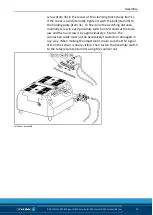
Maintenance and care
40
05.00|21151452 KSP plus-IN, KSP-LH plus-IN, KSP plus-IN2, KSP-LH plus-IN2 |en
27 Screw down the chuck piston (item 3) and cylinder piston (item
4). Tighten the screw (item 14) with a torque wrench (see
28 Fasten the guide strips (item 6) and the covering strip (item 7).
29 Prepare each inductive proximity switch (item 36) with its
hexagon nut and washer (item 34). Insert the counter-supports
(item 32) into the retaining plate (item 31). Screw both
proximity switches into the counter-support with the sensor
facing forward so that the switches are flush or protrude
slightly. Tighten the retaining plate (item 31) and if necessary
the cover to the body (item 1) using the screw (item 35).
30 Screw in each proximity switch by hand until it stops at the
base jaw and then unscrew it by approximately 1.5 turns. Then
fasten the proximity switches to the retainer plate using the
counter nut of the inductive proximity switches. If necessary,
adjust the switching position. The sensor head of the proximity
switches may not touch the base jaws under any circumstances
during operation.
31 Check for leaks.
32 Adjust the inductive proximity switches while checking for
correct signal output.
Leak test
The following components are required to check for leaks:
pressure gauge, shut-off valve and quick coupling.
Check for leaks in the clamping block in the CLOSED position.
• The following is needed to check for leaks: compressed air
supply, pressure gauge, shut-off valve and quick couplings.
• Check for leaks in the clamping system in the OPEN and CLOSED
positions.
1 Connect the components to the open CLOSED connection in
the following order:
pressure gauge, shut-off valve, coupling, supply line.
2 Pressurize the clamping force block.
3 Close the shut-off valve and remove the supply line.
4 Let the clamping block sit clamped for 24 hours.
5 After 24 hours, the clamping force block is:
- sealed if the pressure gauge indicates a drop in pressure of
less than 0.5 bar - leaking if the pressure gauge indicates a drop
7.2
















































